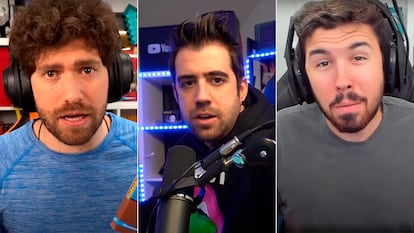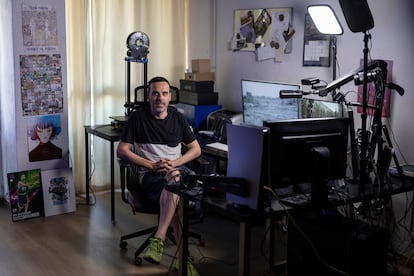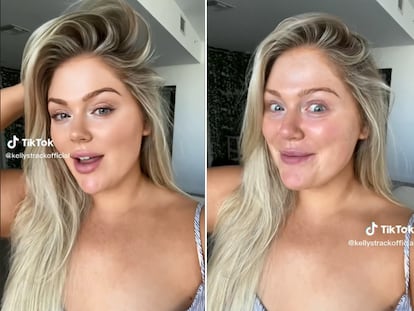Influencers: the thriving business of content creation
Social media platforms have democratized access to large audiences, but making a living from them is challenging

What’s the connection between a TikTok makeup whiz with millions of followers and a short story writer with a loyal group of readers on Wattpad? Or a fast-food delivery driver who live-streams her adventures and a personal trainer who led thousands of people in daily exercises during the pandemic lockdowns? They’re all content creators, a broad term that includes revolutionaries, hedonists, millionaires, anarchists, vegans, reactionaries, travelers and many more. According to a Citibank report, the global value of this industry is over $58 billion (€54 billion) and is projected to surpass $72 billion (€67 billion) by 2024. To provide some perspective, this is larger than the annual gross domestic product (GDP) of countries like Croatia and Lithuania.
A rapidly expanding business is springing up around individuals who are devoted to sharing their experiences or skills through various formats, including video, direct communication, images and text. “It is an emerging sector that originated with a group of young content creators. The content is gaining traction and attracting attention from product brands,” said María Subinas, commercial director of the VIZZ agency, which represents Spanish creators such as El Rubius (over 50 million subscribers on YouTube) and Nil Ojeda. “In recent years, there has been a significant shift towards professionalization in this field. With the emergence of measurement tools and campaign monitoring, creators have come to recognize the professional nature of their work.”
The scale of this phenomenon is vast and involves a diverse range of people, which makes it challenging to quantify the exact number of creators in the industry. According to Goldman Sachs Research, there are approximately 50 million creators worldwide, projected to grow between 10% and 20% annually over the next five years. However, precise figures can be elusive due to the ambiguous definition of a creator, and not everyone can make a living from it. According to Adobe’s “Future of Creativity” study, over 165 million creators joined the global creator economy in the last two years with significant growth in the U.S., Spain, South Korea and Brazil.
Experts agree that the internet and its platforms have facilitated the decentralization of content creation, leading to this boom. Platforms now rival television, attracting young people who increasingly consume content in non-traditional formats. “Content used to be king, because it was hard to make, distribute and monetize, but technology has changed everything,” said Thomas Singlehurst, head of media research at Citigroup Europe. “The ability of legacy media owners to control it has significantly diminished.” However, because anyone with a smartphone can create content, Singlehurst says it’s incredibly difficult to succeed in this business.
It’s truly remarkable, and countless content creators say they were surprised by how it all started. “So, one day I just uploaded this video on TikTok, you know, saying how I wanted to become an influencer. And people really liked it! It actually went pretty viral and that’s where it all began for me,” said Ariane Hoyos. With over 280,000 followers on TikTok and 200,000 on Instagram, Hoyos makes enough money to live off her content creation. “I never even thought that making a video saying I wanted to be an influencer could turn into a legit job!” she said. “Just over a year ago, I became a freelancer when various brands started showing interest in my content, so I started collaborating with them.” Hoyos says she really enjoys her job, despite all the time she spends on coming up with new ideas, and recording and editing the videos.
Making a living from content creation
YouTube and its creative ecosystem contributed $35 billion to the U.S. GDP last year, according to Oxford Economics. The size of the pie is large, but the slices are not at all equal. The vast majority of the income generated from these platforms goes to a small number of content creators. According to Goldman Sachs Research, only 4% of the 50 million creators they track are professionals earning more than $100,000 annually. On YouTube, 5% of the channels account for 90% of the subscriptions, which can be paid or free. On Twitch, Amazon’s live video platform, 90% of the income goes to less than 10% of the streamers. In other words, there is no middle class in this economy.
The bottom feeders of this world include people like Patricia Fernández. She had so many adorable photos of her dog Brus, that she decided to create an Instagram account for him in 2019. Fernández now posts photos of her travels with Brus and has collected over 21,400 followers. She also does a few regional television programs and regularly receives sponsorship offers from businesses. “I don’t make enough money to make a living off Instagram, but I do make some,” she said. There is actually more work involved than it may seem. It’s not just about receiving free products — you have to search for sites, take and edit photos, download apps (which are often paid), and so on. However, like most creators, she currently doesn’t rely on it as a sole source of income and is more focused on her future as a teacher. “Well, some months you don’t get any proposals, and some when everything seems to come at the same time.”

Defining the profile of an average content creator can be challenging due to the immense variety of their work. Despite the widely held perception of a young gamer surrounded by LED lights, research reveals that only 14% of creators belong to Generation Z (those born after 1996). Globally, creators have an average age of around 40, with males (52%) slightly outnumbering females. However, this distribution varies depending on the type of content being created. While men dominate in video production, women have a stronger presence in fields like writing, fashion design, and plastic arts. In terms of employment, 70% of creators work for someone else either part- or full-time, while a smaller fraction are self-employed, according to Adobe.
Elite content creators
On the opposite end of the spectrum lie the elite content creators, who rake in millions every year. According to Forbes, Mr. Beast, the YouTube sensation with a staggering 169 million subscribers, earned an impressive $54 million in direct income solely from YouTube in 2021. But how do these select few make all that money? There are various sources of income, which depend on each individual’s scope. The most common and widespread form is brand sponsorship. In this model, a company pays a content creator to promote or recommend their products to their followers. However, there are other ways to generate income as well, such as payments based on the number of visits or through subscription models. In subscription models, users pay a fee to access the content.
There are other business models as well on platforms like Twitch, favored by creators specializing in live videos — such as streamer Auronplay with over 50,000 subscribers. Subscriptions are not a gateway to accessing content, which is usually free, but a means of offering additional privileges like the ability to message streamers directly. Platforms like Patreon adopt a more traditional model, reminiscent of the Golden Age patronage system where wealthy benefactors commissioned paintings by artists.
The platforms also directly pay top content creators and compete for their talent. Like famous athletes, they join video or streaming sites that entice them with lucrative deals and improved income distribution. In June, KIck (Twitch’s biggest rival) landed an impressive deal worth $100 million over two years with streamer xQc. Platforms like Instagram, TikTok and X (formerly Twitter) have also implemented subscription and payment models to entice content creators. ”It’s a powerful trend that compels platforms to retain these elite content creators because they are the ones who engage the audiences,” said Marta Alonso, senior digital director for LLYC, a global communication and public affairs consulting firm.
Finding the key to success in this profession can be challenging. It often relies on opaque algorithms with ever-changing and often inscrutable preferences. However, there are some common approaches to consider. “The most effective strategies are closely linked to diversification,” said Fabienne Fourquet, CEO of 2btube, a leading talent representation agency and content production company in the Spanish-speaking world. Fourquet says that creators must have a “holistic vision of the market” and understand that it is global. “In Spain, many creators don’t use Facebook and Snapchat since they’re not as popular as other social networks. However, some Spaniards have found success on these platforms by targeting Latin America, where they have millions of followers and generate high incomes.”
In this vast landscape of creators, platforms, and followers, the Spanish-speaking market stands out. According to the Cervantes Institute’s 2022 annual report, over 496 million people speak Spanish as their mother tongue, enabling Spanish-language creators to build large fan bases in Latin America. Bloomberg recently reported that content in Spanish is experiencing rapid growth on Twitch. In July, a boxing match organized by Ibai Llanos broke records on the platform with over 3.4 million viewers.

An advertising magnet
“Why do we engage in this kind of publicity, if not to incite people to revolution?” asked a Nike copywriter in the 1990s. Georgina Rodríguez, a Spanish social media influencer and model, posed naked behind a large Gucci bag with a caption that read, “Carpe diem.” Her Instagram post garnered over three million likes. Bringing a product to market involves reaching the public and appealing to their specific interests. While Nike’s advertising in the 1990s targeted rebellious youth, today it focuses on lifestyles and experiences, with content creators playing a significant role. Spanish advertisers invested nearly $74 million (€63.9 million) in influencer marketing campaigns in 2022, according to Infoadex.
José Diez, the founder of the Lifeislive advertising agency, focuses on campaigns that combine classic advertising strategies with content creators. “To effectively integrate the brand, it’s important to align the brand objectives with the profile of the creator, just like in any marketing vertical,” he said. In a sea of countless creators, agencies like his navigate these waters to find the profiles that best fits the product. They assess profile traffic, content, haters and post frequency. “When you’re telling a story, you let the influencer be natural and align the content with the brand. This approach has worked spectacularly well.”
“The key parameters in advertising include reach, which denotes the frequency of ad exposure, as well as the effective price — that is, the campaign cost in relation to the generated return,” said Citigroup’s Thomas Singlehurst. “It’s widely believed that the creator economy can yield superior returns for advertisers, particularly when targeting niche audiences. However, this assumption does not always hold true.” There are various factors to consider beyond just the number of followers. “The number of followers is not all that important. What truly matters is having an active and engaged community that is willing to pay for your content,” said LLYC’s Marta Alonso.
Whether through videos, audio clips, photos or live streams, content creation has emerged as a thriving business that captivates both consumers and brands alike. Its impact is undeniable, prompting traditional media outlets to shift from competition to collaboration. Take, for instance, the recent Mediaset (Italy’s largest commercial broadcaster) airing of the Kings League soccer matches that were also live-streamed on the league’s official Twitch, YouTube and TikTok channels. Although content creation is more accessible, its soaring popularity should not overshadow the fact that not everyone is on equal footing. Just like in professional sports, elite content creators are a rarity.

Roc Massaguer can proudly say he was a content creator before the term was coined. Back in 2010, when only a handful of kids were showing off their Call of Duty gaming skills on YouTube, Massaguer instead decided to create a channel that showed how bad he was at video games. He was among the pioneers who turned their passion into a lucrative business by monetizing YouTube videos. Today, Massaguer’s Outconsumer channel has over 780,000 subscribers and he can honestly claim to make a living from content creation. But his message is clear: “It’s very hard to make a go of this.”
Massaguer started uploading videos in December 2010 and didn’t make any money from YouTube until nearly a year later when he snagged an advertising campaign from a video game company. He chuckles, remembering how people back then said anyone who had advertisements in their videos were sellouts. “Initially, I juggled it with my work [he was a journalist reporting on Spain’s ACB basketball league], and I told my wife not to let me give up my steady job for this.” But the couple couldn’t foresee the rise of content creators. In October 2013, his big break happened when he was offered an opportunity to host a four-month program on Televisión Española, Spain’s national state-owned public television broadcaster. “I never looked back.”
However, the YouTube to which Massaguer uploaded his elaborate video-game narratives bears little resemblance to the platform today. “Back then, the algorithm was simpler, more predictable. I remember being able to calculate how many views a video would get, which made it easier to plan and build your business.” Then, YouTube changed it remuneration policy without notice, leading to a mass exodus of creators. “They realized that they had too much content to sell to companies,” said Massaguer, who attributes the restriction of monetizable content as the main reason for leaving the platform. “You had no idea how many views you’d get, how they’d pay or how many ads they’d put up.”
That change happened around four years ago, and most video creators moved to Twitch, relegating YouTube to a secondary platform for many. “I can spend two hours a day on Twitch and make the same money. But on YouTube, that wasn’t enough time to even think about a video, let alone record and edit it.” Although his videos are less elaborate, the content isn’t worse. “It’s more personal now,” he said, which leads people to donate. The main monetization methods are paid subscriptions and direct donations. “The Kings League doesn’t care about subscriptions — people donate money to them like crazy.”
With Outconsumer, Massaguer transitioned from creating videos for fun to building a devoted community and earning a living through content creation. Still, he acknowledges the challenges of making a living in this field and doesn’t rely solely on direct platform income. Massaguer generates additional revenue through collaborations and sponsorships. ”We’re very fortunate, but let’s be real with those who want to pursue this — it’s highly likely they won’t succeed.”
Sign up for our weekly newsletter to get more English-language news coverage from EL PAÍS USA Edition
Tu suscripción se está usando en otro dispositivo
¿Quieres añadir otro usuario a tu suscripción?
Si continúas leyendo en este dispositivo, no se podrá leer en el otro.
FlechaTu suscripción se está usando en otro dispositivo y solo puedes acceder a EL PAÍS desde un dispositivo a la vez.
Si quieres compartir tu cuenta, cambia tu suscripción a la modalidad Premium, así podrás añadir otro usuario. Cada uno accederá con su propia cuenta de email, lo que os permitirá personalizar vuestra experiencia en EL PAÍS.
¿Tienes una suscripción de empresa? Accede aquí para contratar más cuentas.
En el caso de no saber quién está usando tu cuenta, te recomendamos cambiar tu contraseña aquí.
Si decides continuar compartiendo tu cuenta, este mensaje se mostrará en tu dispositivo y en el de la otra persona que está usando tu cuenta de forma indefinida, afectando a tu experiencia de lectura. Puedes consultar aquí los términos y condiciones de la suscripción digital.
More information
Archived In
Últimas noticias
Petro claims the ELN was the target of US attack in Venezuela
Maduro counterattacks Trump with rhetoric and announces downing of nine drug trafficking aircraft
‘Ecce Homo’: The miraculous disaster that made a small Spanish town famous
Return to sex testing at the Olympics: IOC edges closer to banning transgender women
Most viewed
- Sinaloa Cartel war is taking its toll on Los Chapitos
- Oona Chaplin: ‘I told James Cameron that I was living in a treehouse and starting a permaculture project with a friend’
- Reinhard Genzel, Nobel laureate in physics: ‘One-minute videos will never give you the truth’
- Why the price of coffee has skyrocketed: from Brazilian plantations to specialty coffee houses
- Silver prices are going crazy: This is what’s fueling the rally










































